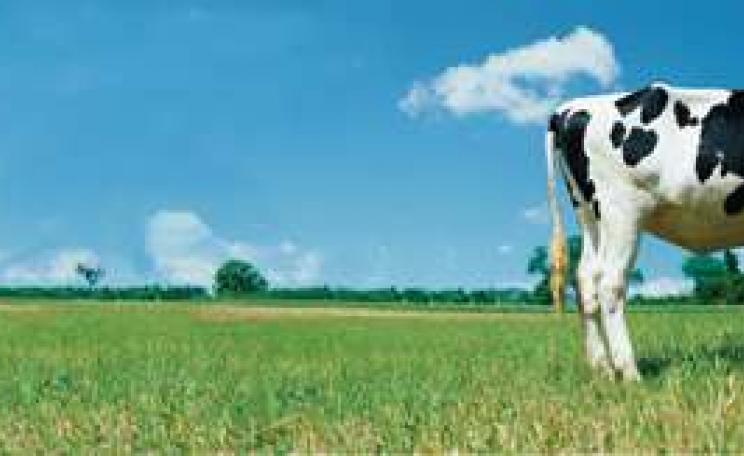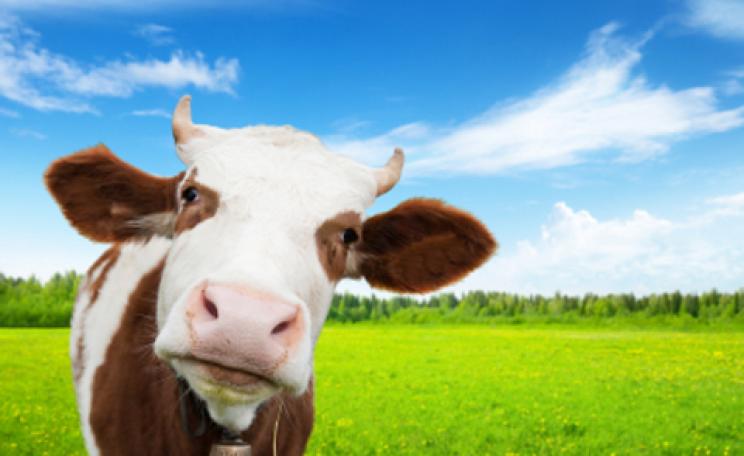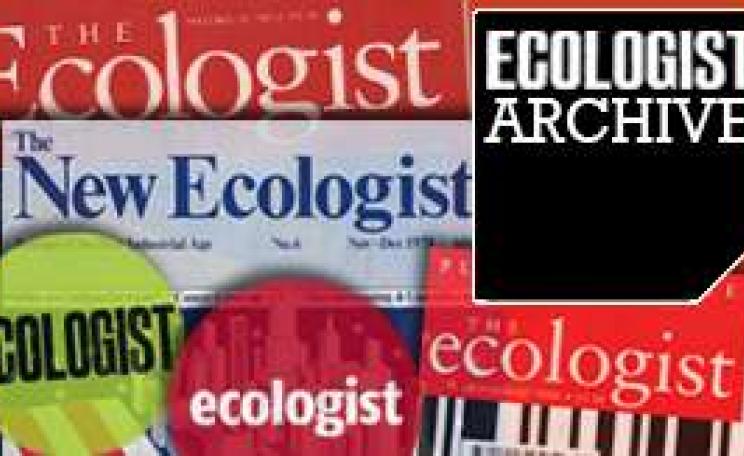Ever seen a happy farmer? It is rare that a smile cracks the glum mien of most farming pundits and practitioners. And you can hardly blame them, given modern agriculture’s perennial crop of bad news stories: BSE; Foot and Mouth; the ongoing exodus of 12 farmers from the land every day… Yet as a city-confined environmentalist, so deprived of direct contact with nature and food production that I call my compost bin worms a ‘herd’, farming seems an enviable way of life, one that utilises mind and muscles in a variety of tasks and skills, and which offers endless fascination and, yes, fun. Is this just the naiivety of a city dreamer romancing the hard business of commercial food production? No, not necessarily, as I recently discovered while on a visit to Kite’s Nest farm in the Cotswolds.
Kite’s Nest is farmed by the Young family: mother Mary, and her son Richard and daughter Rosamund. Within minutes of arriving, both myself and Jo, the photographer accompanying me, had huge grins on our faces as we were hurtled about the fields in a clapped-out old Range Rover driven by Rosamund. The now frail, but indomitable Mary was wedged with improvised hot-water bottles into the passenger seat. Our mission? Taking perfectly good but supermarket-rejected organic apples out to the Youngs’ cattle and sheep for their routine bedtime treat. Meeting the livestock in the fields above the farmhouse, with dusk falling and, as Mary pointed out, the rooks gathering on the ground ‘to discuss the day’s doings’ before swooping off to roost, was certainly a treat for a pair of reluctant urbanites.
But the Youngs’ farm has a more significant purpose than merely providing a tonic for jaded, nature-starved city dwellers. The practice and philosophy of farming followed by the family offers lessons and techniques that, if understood and adopted more widely, could revive the general fortunes of agriculture in this country; they might even bring a smile back to farmers’ faces. The Youngs are organic farmers and have been since 1953, when Mary and her husband started farming. They hadn’t heard the term ‘organic’ then, but simply made a conscious decision to resist the urgings of the ‘men from the ministry’ to ‘modernise’; they were convinced that traditional techniques offered a better way of life and more secure system for both them and the animals in their care.
The word that best describes what goes on at Kite’s Nest is ‘husbandry’, in the term’s original meaning of ‘the management and administration of a household’. By ‘household’ is meant the whole farm and all that live in and on it – including the animals, which at Kite’s Nest are actively engaged in deciding and amending the farm’s management. The Youngs believe this makes obvious common and commercial sense. ‘Making animals happy and allowing them to express their natural behaviour and instincts is not just morally and ethically essential; it also makes sound financial sense. Happy animals grow faster.’ Science is playing catch-up. A recent press article reporting a ‘new initiative’ set up by the Zoology Department at Oxford University talked excitedly about ‘a unique farming laboratory [in which] the animals are effectively being asked to design the farm themselves’. Such a system has been running at Kite’s Nest for decades.
Despite tracing her farming roots back to 17th century royalists, Mary Young describes herself as a ‘communist’, and praises Castro’s Cuba for its national health service and wholesale adoption of organic farming. (The latter was enforced by the US trade blockade and Cuba’s no longer being able to access cheap pesticides and fertilisers following the collapse of the Soviet Union.) Here in the Cotswolds a quieter revolution has been gathering pace over 50 years, its manifesto set out in Rosamund’s gently titled book The Secret Life of Cows. The book records the Young family’s observations and anecdotes about Kite’s Nest’s other inhabitants: the Hat, Bonnet, Discount and High Noon cattle dynasties; Audrey, ‘the helpful and friendly’ sheep; Audrey’s rather dull and less ‘inventive’ friend Sybil; and the hens, which ‘of all farm animals… are usually, if given freedom and access to a wide variety of food and lots of pure water, the most independent creatures’.
How sentimental and uncommercial! Conventional farmers distance themselves from their livestock, and any nagging doubts as to the systems they put them through, by knowing them only by the numbers on their ear-tags and breeding records. Yet the stories and anecdotes in The Secret Life of Cows are not mawkish fancy, but serve a real, practical purpose. Close observation of individual animals brings familiarity with their idiosyncrasies. That helps farmers know how animals are likely to react in different circumstances, making necessary adjustments to their routine easier to manage. As Rosamund writes in her book, ‘the better you know the animal the more use you can be to it. If you know how it is likely to react in various circumstances you can be prepared… Unusual behaviour needs investigating’. So, when the Youngs’ normally self-reliant cow Fat Hat appeared in the yard while the rest of her group grazed contentedly up the hill, Rosamund knew something was up. It turned out that a length of fencing wire had become tangled about her legs. Once attended to, Fat Hat returned to her solitary ways, but not before looking back in what Rosamund describes as ‘grudging admission that humans do occasionally have their uses’.
Mary’s remark that ‘animals want to be left alone really’ does not reflect neglect or laziness on the part of the Youngs. Indeed, they spend a great deal of time paying close attention to what their animals are doing, but only intervene when necessary or they are ‘asked’. Constant disruptions to and dictations of animals’ lives cause undue labour and stress to both farmer and livestock. Often such interference is driven more by the needs of the pharmaceutical companies’, which play on farmers’ fears about disease and loss of profit in order to maintain their sales, than any genuine welfare necessity.
The Secret Life of Cows reveals the dignity and delight proper farming accords livestock and farmers alike. But there’s a radical conclusion to be drawn from Rosamund’s most remarkable observation: that animals ‘self-medicate’, searching out certain plants, herbs, shrubs and trees to treat specific ailments or nutritional deficiencies. Thus, immediately before and after calving cows seek out nettles as a readily available source of iron; docks, normally ruthlessly sprayed out as a sign of an ‘untidy’ pasture, are selected by animals needing a boost in minerals or trace elements such as copper, which are brought up from deep underground by the plant’s 10- to 30-foot roots; and animals that have bruised or strained muscles in a fall or during horse-play will eat willow leaves: their equivalent of knocking back a couple of aspirin.
The whole edifice and justification of modern livestock farming hangs on denying that animals have intelligence, individuality and sensitivity, and on reducing the independence and self-reliance of farmers and their farms. Conventional modern grassland is species-poor, with only two or three grasses. It is designed to maximise milk yield, but requires heavy applications of artificial fertiliser. Healing herbs are largely absent from such pasture, their properties supplied at a cost by extra mineral licks, supplements and drugs bought in off-farm from feed and pharmaceutical companies. Forgetting the husbandry of their fields, passed down by their forebears, farmers become ignorant of the instinctive wisdom of their own animals and fall prey to commission-driven salesmen racking up their drug, veterinary and fertiliser bills. It’s hard not to conclude that there’s been a conscious conspiracy to discredit and undermine the self-confidence of farmers, substituting traditional knowledge of land and livestock with drugs and chemicals, and all to the supplying companies’ profit.
Noting the plants, herbs and shrubs chosen at various times in the year by individual animals for different reasons, gives the Youngs detailed information on the health of their livestock and on what mix of sward will maximise general wellbeing; it has also proven the value of their allowing their animals access to additional hedgerow and woodland browsing. But really, such intelligence and resourcefulness in farm animals should not be so remarkable. David Attenborough fans will be familiar with images of elephants trekking miles to tusk out vital salts from caves used by generations of their forebears, and any cat or dog owner will have seen their pets eating grass to cure stomach upsets.
By putting the wellbeing and satisfaction of their animals first, the Youngs are also prioritising the commercial wellbeing of the farm business. ‘Satisfied animals are happier, healthier animals’. That means they put on weight and the right balance of muscle to fat. As a consequence, Kite’s Nest is producing the best meat for human consumption. The farm’s customers clearly believe there’s something special about the meat: not just the ethics of its production, but its quality and taste, as well, with some customers travelling from Scotland to stock their freezers.
The Youngs’ enthusiastic and loyal customers bring more than just money. Farming is a lonely occupation nowadays, with a minority of farmers selling direct to the public. The only visitors most would normally see are chemical, drug and machinery company reps seeking to flog them something, or Whitehall officials checking up on the myriad forms farmers have to complete. The Youngs’ visitors stay awhile, fascinated by what is going on, enjoying a system that fulfils their aspirations of what proper, ethical farming should be like. Few farmers could reel off such a list of diverse and distinguished visitors as Mary Young can. To name them would be indiscreet, but they range from royalty, rock stars and TV news anchormen, to leading microbioloigists. The Youngs also have several customers with severe medical conditions, who have found their systems can only tolerate Kite’s Nest produce: something Rosamund describes as ‘a humbling responsibility’.
Accepting the lessons Kite’s Nest teaches is not always easy, especially for those hardened in their ways. This is well illustrated by a story Rosamund tells about Amelia, a cow and character about whom she says: ‘I could write for a thousand pages, listing every detail of Amelia’s life and I still would not have presented an even half-accurate picture of her.’ The Youngs had hired an elderly farm-worker who, Rosamund says, ‘had been taught to talk gruffly to cows, hurry them, let them know who was boss; taught, in actual fact, to be afraid of them while never admitting it’. Coming to help move a group of cows meandering their way to graze, the farm-worker initially sought to drive them at his pace. On being told that Amelia could find her own way at her own pace, he paused, noting in increasing amazement her interest and investigation of everything en route. Appreciation and friendship began. ‘To his immense delight,’ Rosamund says, ‘Amelia persuaded him to like and enjoy the company of cows.’
Farming journalists and industry pundits complain that young people don’t want to work in farming because ‘it’s boring’ or ‘not adequately rewarding’. It certainly is boring, after the first macho thrill, to sit detached from the soil aloft a huge tractor driving up and down a featureless field all day. And it is boring if you’re told that cows, sheep, pigs and poultry are simply units of production, without character, individual needs or rights, and therefore not worth learning anything about other than how to grind them through the system. Constraining all capacity for learning, factory farms are as soul-destroying for the human cogs serving them as for the incarcerated animals they exploit. Yet there’s nothing boring about farming the Kite’s Nest way; no shortage of incidents to observe and learn from; indeed, more than enough for any one person to learn in a lifetime. ‘something happens every day… But many of the happenings inevitably go unnoticed’.
Kite’s Nest is still a commercial farm, however, with the animals ending up on someone’s plate. And for vegetarians no degree of care and attention during the animals’ lives will make up for their final end. But the Youngs’ way of farming is a more effective indictment of intensive livestock systems than most animal rights’ campaigns, which conventional farmers dismiss out of hand as totally detached from their working lives and experience. The Secret Life of Cows provides scientific evidence (for science is fundamentally about observation) by working farmers, not just of the sentient nature of farm livestock, but of their individual characters, intelligence, capacity for learning and recognition of their keepers. That evidence condemns the intensive livestock industry’s innate cruelty, shaming it for its cowardice and inability to confront its crimes, and proving there is another way.
During our visit to his family’s farm, Richard Young was preoccupied assisting at the birth of the latest addition to the Bonnet family: December Bonnet, calf and daughter of January Bonnet. Richard is clearly a hands-on working farmer. But that hasn’t stopped him from mounting a prolonged and direct assault against the intensive livestock industry. In particular, he continues to challenge its dependence on antibiotics: the pharmaceutical crutch propping up the disease-ridden, unethical and dangerous industry. Over the years, working with the Soil Association as an on-farm campaigner, he’s succeeded in getting seven antibiotic animal drugs withdrawn from use.
Antibiotics can play two roles in intensive and general livestock farming: added routinely to feed or drinking water, they suppress certain gut flora in animals and act as growth promoters, enabling pigs and poultry to put on weight and be ready for slaughter much faster than is natural; used therapeutically, they curb outbreaks of infection that would regularly occur among the thousands of animals or birds crammed tightly together in intensive systems. Thanks to the efforts of Richard and other campaigners, the use of antibiotics for promoting growth has now been banned in the UK. And the therapeutic application of antibiotics is meant to be administered on prescription in response to a disease outbreak. In practice, however, antibiotics are routinely administered both to prevent disease and to promote growth. This is borne out by the fact that their therapeutic use has increased by more than 30 per cent. The only possible conclusion is that unscrupulous vets are prescribing them for therapeutic purposes, knowing full well that farmers are administering them as growth promoters.
If keeping animals in unhealthy conditions to produce ‘cheap’ unhealthy meat weren’t bad enough, intensive livestock farming’s excessive use of antibiotics, several of which belong to the same ‘family’ of antibiotics used in human healthcare, has resulted in a surge in multiple-drug-resistant bacteria, including the ubiquitous hospital super-bug MRSA. This threat to human health has prompted a ban on the use of antibiotic growth-promoters across the EU, which will come into force in 2006. Richard and his fellow campaigners may have succeeded in kicking the crutch from under the legs of the intensive livestock industry. If they were to apply the knowledge of husbandry set down in the book by Richard’s sister, knowledge gleaned by the Young family over a period of 50 years, intensive livestock producers might survive the withdrawal of their drugs and relearn how to farm in a way that recognises the limits of nature and respects the individuality and rights of farm animals.
As we bounced across the fields, Mary Young reassured us we were in safe hands as her daughter ‘had been a rally driver’. I mused that agriculture needs someone like Rosamund at the wheel. Unfortunately, it’s currently being driven straight into a tree by Jeremy Clarkson types: people with narrow, selfish and destructive views. Diverted from this absurd analogy by an inquisitive head poking through the window, I exclaimed, ‘hello sheep!’, only to be immediately and rightly rebuked with the words ‘that’s not a sheep, that’s Ellen’.
To order a copy of Rosamund Young’s book The Secret Life of Cows (£14.99, ISBN 0-9542555-5-0), contact Farming Books and Videos on 01772 652693 (www.farmingbooksandvideos.com); Robin Maynard is national coordinator of Farm, the campaigning organisation for independent farmers
__________________________________________________________________________
THE LOST ART OF HUSBANDRY
Husbandry once applied to all areas of farm practice and learning. It encompasses a wide range of skills and techniques developed and laid down over generations. Today, agricultural colleges substitute the narrower term ‘science’ to describe their courses, so animal husbandry is reduced to animal science. Indeed, science has been raised from a component to the dominant and only essential part of the knowledge necessary to raise crops or livestock. Consequently, farmers are reduced to the status of serfs, slavishly applying the ‘scientific’ products of the agrochemical and pharmaceutical industries upon which their systems now depend.
In contrast, husbandry is a noble art, engaging and developing the intelligence, intuition and instinct of those practising it. Subtle understanding of psychology and ecology is brought to bear, and applied in combination with the foundation knowledge of plant and animal biology, along with practical mechanical and engineering skills.
Husbandry expands the brains of both farmer and animals. Studies show that the lack of stimulation for animals confined in intensive systems literally shrinks their brains. One of Kites Nest’s customers is an eminent scientist who has been comparing the craniums of dead cattle for 20 years. He found a pattern of shrinking brain size, which he put down to poor conditions and diet. He concluded his study before the first confirmed case of BSE.
This article first appeared in the Ecologist March 2005







